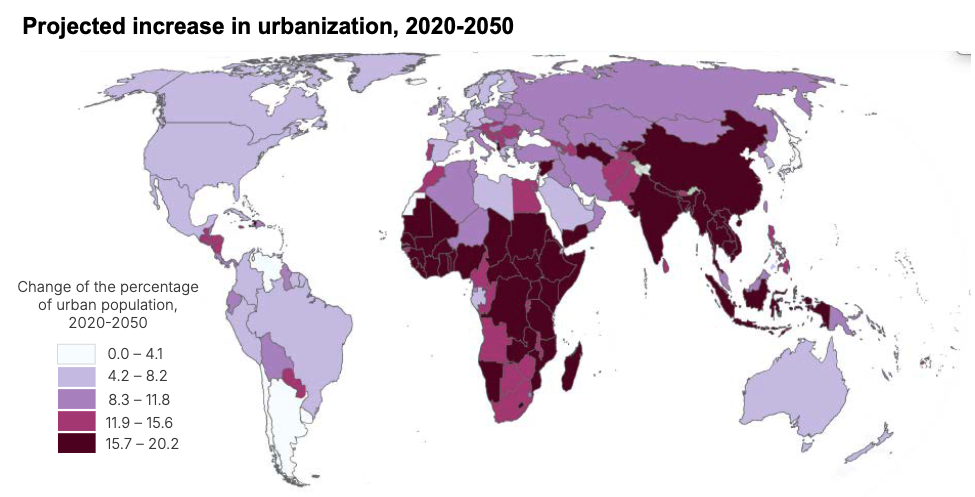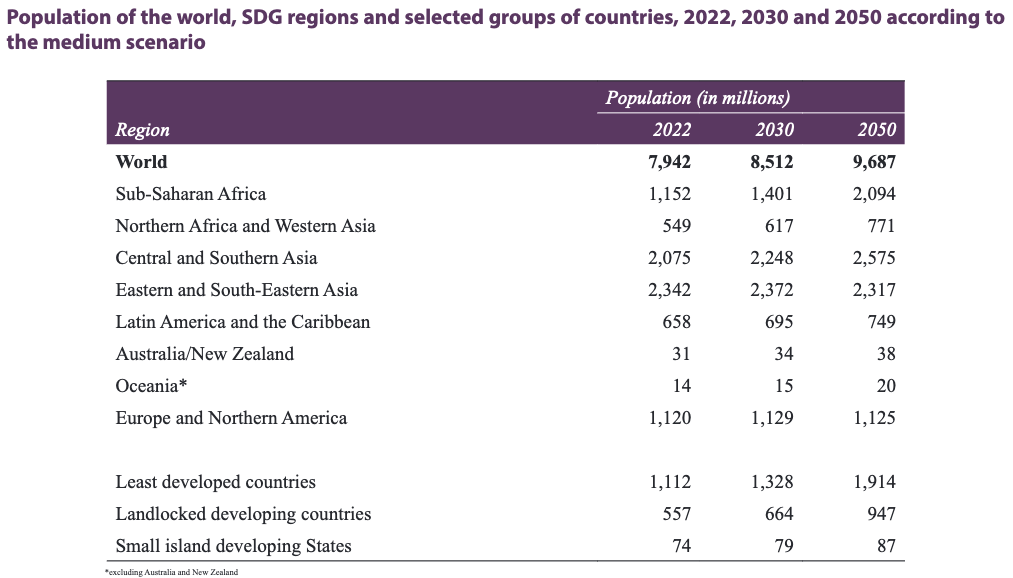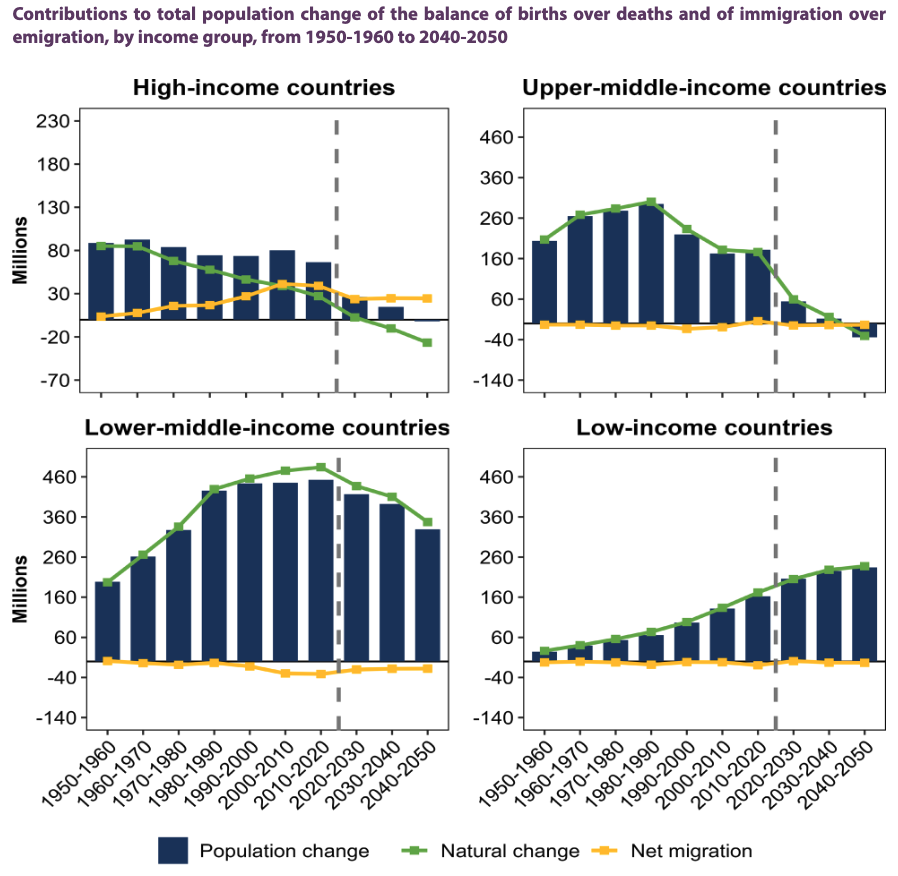Demographic trends (such as population growth, demographic composition, age structures, urbanisation, and migration) vary greatly between and within countries and regions. Often, these diverse demographic situations lead to structural changes and demand pressures in many systems including the food system.
The world’s population is expected to increase by two billion people, from 7.7 billion at present to 9.7 billion in 2050, before reaching a peak of nearly 11 billion by the end of the century as fertility rates continue to decline (UN, 2019). During this period, the global population is projected to become more and more urban, while children below age 5 will be outnumbered by persons aged 65 or above. Meanwhile, people are on the move. While the percentage of international migrants has remained around 3 per cent of the global population over the past two decades, their number has increased by more than half since 2000. At the same time, the number of people forced to flee their homes has risen sharply due to protracted conflicts and could increase further due to climate change and environmental degradation. The United Nations Secretary-General considers demographic shifts one of the most important megatrends defining progress towards the Sustainable Development Goals (SDGs).
This section presents selected data on key trends within demographics:
- Population Growth
- Urbanization
- Age Structure
- Migration
1. Population Growth
Future trends
There is a probability of 95 per cent that the size of the global population will lie between 8.5 and 8.6 billion in 2030, between 9.4 and 10.1 billion in 2050 and between 9.4 and 12.7 billion in 2100 (United Nations, 2021). While some countries are concerned about rapid population growth, others worry about rapid decline. Concerns about both “overpopulation” and “underpopulation” are fuelled by other global concerns, including climate change, pandemics, conflicts, mass displacement and economic uncertainty. Half of global population growth between now and 2050 is expected to come from just nine countries: India, Nigeria, Pakistan, the Democratic Republic of the Congo, Ethiopia, Tanzania, Indonesia, Egypt and the United States of America (in descending order of increase)and in contrast, China and Japan will record largest population loss. (FAO, 2022).
Implications

The rapid population growth and the associated increase in resource footprint are significant challenges, particularly in low-income countries and Small Island Developing States (SIDS) that are highly vulnerable to climate change. Additionally, progress in SDG 8 (Decent Work and Economic Growth) and SDG 12 (Responsible Consumption and Production) highlights the complex challenge of achieving sustainable economic development in the context of growing populations and limited resources.
2. Urbanisation
Future trends
Today, around 55 per cent of the world’s population lives in towns and cities, with the level of urbanisation projected to reach almost 70 per cent by 2050. Much of the growth in urban populations will take place in Asia and Africa, especially in China, India and Nigeria where the fertility rates remain high (UNFPA, 2024).
Implications
Some of the urban growth comes from urban fertility, but it also reflects internal migration to urban areas, leaving some countries with rural ghost towns and underdevelopment. Urbanisation is also directly reshaping the global food system, leading to increased demand for processed, convenient foods and resource-intensive products like meat and dairy, driven by changing urban lifestyles. The urban poor are particularly affected, as many live in food deserts where access to affordable, nutritious food is limited, exacerbating food insecurity. Additionally, shifting dietary choices in urban areas towards high-fat and high-sugar foods are contributing to rising rates of noncommunicable diseases. This dietary transition, coupled with significant food waste in urban areas, poses major sustainability and food security challenges globally (FAO, 2022).

3. Age Structure
Future Trends
It is projected that by 2050, the number of individuals aged 65 years or above across the world will be twice the number of children under age 5 and almost equivalent to the number of children under 12 years. At the world level in 2022, approximately 10 per cent of people were aged 65 or over. The proportion of older persons in the world is projected to reach nearly 12 per cent in 2030 and 16 per cent in 2050. At present, 11 per cent of the world’s population lives in countries with more older people than children, a proportion that will reach 36 per cent by 2050. The pace and scale of ageing worldwide will be highly diverse, with the fastest transitions occurring in middle-income countries. In sub-Saharan Africa and South-East Asia, over the coming decades, the number of older persons is projected to grow, faster than all younger age groups. At the same time, youth bulges will also be seen in other African countries (World Population Prospects, UN, 2022).
Implications

Source: World Population Prospects 2022
The increasing trend of elderly population in high- and middle-income countries means that an increasing share of young people worldwide is expected to live in countries confronting substantial structural barriers to their development such as a lack of employment opportunities. This can exacerbate the challenge of eradicating poverty (SDG 1) and increasing financial burdens related to health and social security. These anxieties, in turn, link to fears for the future of institutions and systems impacted by demographic patterns, especially labour/worker availability and diversions (UN, 2021).
4. Migration
Trends
More than 1 billion people living in developing countries have moved internally as part of economic transformation; rural-urban and rural–rural migration flows are part of this process. However, considering the megatrends that affect migration flows, including uneven economic development, climate change, natural disasters and conflicts, international migration is likely to accelerate. The international movement has also seen a boost post-Covid. Projections on international migration clearly show an increase in immigration impacting population change in high-income countries while not much will change for other economic groups (World Population Prospects, UN, 2022).
Implications

The future of migration is highly uncurtaining considering the megatrends it depends on. In the past, migration has significantly contributed to the growing urban population in some regions while emigration has led to decrease in population in others. In low- and middle-income countries, emigration from rural to urban areas can result in labour shortages in rural areas and inequalities in urban areas, affecting food security. However, remittances sent back by migrants moved to high-income countries can support rural economies by providing funds for investments in agriculture, education, and infrastructure (FAO, 2022). The reduction of agriculture contribution to GDP and decrease in agriculture value added has also been attributed to movements of the workforce to urban areas, witnessed more significantly in China, South Asia and East Asia Pacific.
Important Data Sources
The United Nations Population Fund (UNFPA) regularly publishes the newest trends and future projections on various indicators of shifting demographics here. Their latest report “Demographic Change and Sustainability” presents key demographic megatrends and their projections. The International Organisation for Migration reports on international and national migrations. The latest “World Migration Report 2024” report can be found here.
Please email info@foresight4food.net if we are missing any data updates.